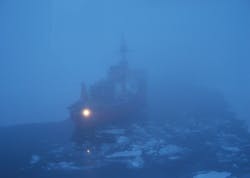Navy wants sensors that penetrate through fog, haze, rain, and snow
ARLINGTON, Va. - U.S. Navy shipboard electronics experts are reaching out to industry to find new sensor technologies to enable surface warship and submarine crews to capture images through difficult obscurants like fog, haze, rain, and snow.
Officials of the Office of Naval Research (ONR) in Arlington, Va., issued a request for information last month (N00014-16-RFI-0001) for the electro-optical Imaging Through Obscurants project, which seeks to deal with fog, haze, rain, and snow, but not with dust or smoke.
Navy vessels often must operate in congested waterways throughout the world, where they must use electro-optical (EO) and infrared (IR) sensors for situational awareness and target detection, tracking, and identification. The short wavelengths of EO/IR sensors, however, make imaging far more susceptible to performance degradation from the scattering of water-based aerosols. Imaging through dense fog is the intrinsic hard problem, researchers say.
To deal with these problems, ONR officials are considering sensor post processing that uses prior information about the scene, as well as overcoming limitations that scattering water-based aerosols impose on the signal-to-background ratio of EO/IR sensors.
Researchers are interested in active imaging techniques with approaches like structured laser-light illumination and temporal gating. Navy experts also are interested in passive imaging techniques that use a judicious choice of spectral bands, polarization diversity, high-speed multi-frame acquisition, or other mode of acquisition together with advanced signal processing.
Proposed solutions may involve spectroscopic properties of obscurants, and use all or any portion of the electromagnetic spectrum ranging from the ultraviolet to the far infrared, including visible light, near-infrared, shortwave infrared (SWIR), midwave infrared (MWIR), and longwave infrared (LWIR). Researchers say they are not interested in millimeter-wave solutions.
Companies interested were to e-mail ideas no later than 19 Feb. 2016 to the Navy's Ravi Athale at [email protected] with "RFI: Imaging through Obscurants" in the subject line. E-mail questions to Athale at the above address.
More information is online at www.fbo.gov/spg/DON/ONR/ONR/N00014-16-RFI-0001/listing.html.

John Keller | Editor
John Keller is editor-in-chief of Military & Aerospace Electronics magazine, which provides extensive coverage and analysis of enabling electronic and optoelectronic technologies in military, space, and commercial aviation applications. A member of the Military & Aerospace Electronics staff since the magazine's founding in 1989, Mr. Keller took over as chief editor in 1995.

